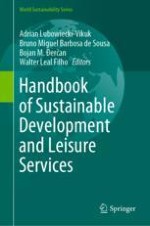2021 | OriginalPaper | Chapter
Physical Activity of Male and Female University Students as a Manifestation of Sustainable Development
Authors : Daniel Puciato, Michał Rozpara
Published in: Handbook of Sustainable Development and Leisure Services
Publisher: Springer International Publishing
Activate our intelligent search to find suitable subject content or patents.
Select sections of text to find matching patents with Artificial Intelligence. powered by
Select sections of text to find additional relevant content using AI-assisted search. powered by
